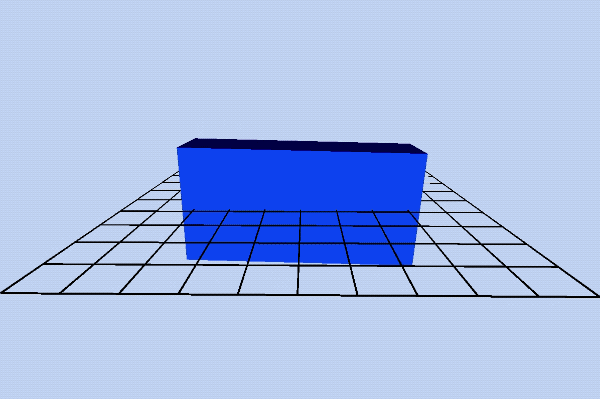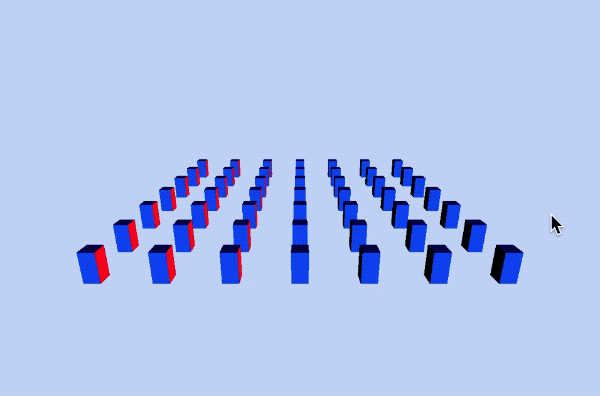Over the course of this Google Summer of Code 2018 project for The Processing Foundation, I worked along with Adil Rabbani and our mentors Kate Hollenbach and Stalgia Grigg to further expand and improve p5.js' WebGL implementation. I focused specifically on helping beginner coders visualize and understand 3D space through an expanded orbitControl(), reorganization and expansion of the camera and a debugMode().
Having never before contributed substantially to open-source, I began the summer by getting up to speed on p5.js' contribution practices, the automated build process and working with git on our shared webgl-gsoc-2018 branch. During this time, I worked on improving existing WebGL mode documentation here and here. In addition, fixing minor bugs (here, here, here and here) helped enormously to understand how the WebGL mode and broader p5.js codebases interacted with each other, with the browser and with the graphics card, as did a deep and ongoing friendship with the Chrome Debugger.
Along with this work, I found it extremely helpful to learn and use 'vanilla' WebGL outside of the p5.js ecosystem. Without the implementation-specific complexity of a library, I found it much easier to see how the various elements of a WebGL canvas interact. This series of videos is particularly thorough in setting up a WebGL context, writing shaders and creating a program, and implementing the various matrices necessary for a 3D scene. To develop a more high-level background on the matrix math underlying 3D graphics and an intuitive sense of how matrices are composed, I found this series of videos very helpful. Among the dozens of articles I found on 3D cameras and projection, the chapters on camera control and projection in 'Learn WebGL' were particularly helpful in developing an approach to the p5.Camera object reorganization.
orbitControl() allows a user to control the camera view of a sketch with the mouse. It is a very quick and easy way to debug code, better understand the 3D coordinate system and how other other p5.js WebGL functions (rotateXYZ(), translate(), perspective() and ortho(), for instance) manipulate objects and view within a 3D sketch. Building upon the existing orbitControl(), which allowed two-axis rotation of a sketch, and with the goal of implementing similar functionality to this set of three.js controls, I went to work on adding several features: persistence (rotation would not reset after the mouse is released), maintaining Y-Up orientation, and pan and zoom control.
Adding all of this to a single function turned out to be somewhat unwieldy within the existing structure of the p5.RendererGL object, however, and helped prompt the decision to move all camera functionality into a separate p5.Camera object. This done, orbitControl() was rebuilt to use the p5.Camera object here.
Reorganizing all camera code into a separate p5.Camera object here proved useful for two reasons: internally, it further modularized the WebGL codebase, allowing expansion of the camera while simplifying the rendererGL object, and externally, it allowed users to store references to and manipulate a camera object directly. The p5.Camera has several new methods and several 'wrapper' methods which simplify camera control (pan(), tilt(), move()) and the user can now store, manipulate and switch between several p5.Camera objects using the setCamera() method.
let cam1 = createCamera(); // create an instance of p5.Camera object
cam1.pan(angle); // pans the camera by an angle
cam1.tilt(angle); // tilts the camera by an angle
cam1.move(x, y, z); // moves along the camera's local axes
cam1.setPosition(x, y, z); // sets the camera's position in world-space
let cam2 = cam1.copy(); // create a copy of the camera
setCamera(cam2); // switch between multiple p5.Camera instancesThis reorganization also required adding p5.Camera object unit tests to the library's mocha/chai automated testing framework. Unit testing was a wholly new subject to me, and the variety of testing approaches touted online (and their various acronyms: TDD, BDD, etc.) was somewhat overwhelming. My mentor Kate was extremely helpful in guiding me through this process, as was a close reading of the existing p5.js unit tests. Unit tests can be found here.
Because human depth perception is based in numerous visual and contextual clues often absent from 3D sketches -- especially simple sketches without lighting -- it can be challenging for a beginning coder to visualize and understand the 3D coordinate system in a WebGL mode sketch. For my final project of the summer, I began work on a debugMode() function to help visualize depth and camera orientation in a 3D sketch. This function allowed a user to add a gridded 'ground' plane and axes icon to their sketch with a single function call. These visual guides will, along with the use of orbitControl() make depth and orientation immediately apparent within a sketch. Code for this can be found here.
 |
 |
|---|---|
| Are we moving or is the box moving? Which way is up? | Easier to identify orientation and movement with debugMode() |
A full list of my contributions to the WebGL branch can be found here and my merged pull requests can be found here.
Working on this project for p5.js has been an incredible learning experience and a joy. I am extremely grateful to the Processing community and especially to my mentor, Kate Hollenbach, for a summer's worth of guidance, debugging, git tutorials, WebGL articles and support. Thank you!
